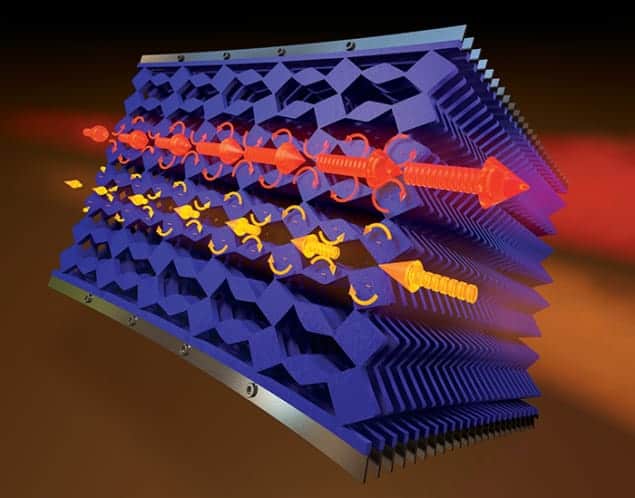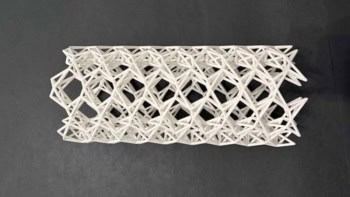
A mechanical metamaterial that responds strongly to motion from one direction, while blocking it in the other, has been developed by an international team of researchers. The research, which in principle at least breaks a fundamental assumption of mechanical engineering, could have applications ranging from shock absorption to prosthetics and robotics.
An important property of the new material is its ability to overcome reciprocity – a fundamental principle that governs many physical systems. It refers to the symmetrical transmission of energy between two points in space. Regardless of which point the energy is travelling from and to, it should behave identically in both directions. Mechanically, reciprocity implies that if you push on one side of an object, you should get the same response if you were to push on the opposite side – the motion travels through the object symmetrically.
Andrea Alù at the University of Texas at Austin in the US has previously worked on overcoming reciprocity for wave propagation. His past work includes producing acoustic isolators that transmit sound in only one direction and antennas that will not listen to their own echo.
Collaborative idea
While Alù was on sabbatical, he and Corentin Coulais of the Foundation for the Fundamental Research on Matter Institute for Atomic and Molecular Physics (AMOLF) in the Netherlands had an idea about a non-reciprocal metamaterial. Coulais previously worked with carefully designed mechanical metamaterials that respond in unusual ways to stimuli, and the researchers decided to combine their interests to produce a mechanical metamaterial that would behave non-reciprocally in response to time-invariant forces.
The researchers designed two non-reciprocal metamaterials that respond much more strongly to forces from one side than from the other. The first was a rubber-made, centimetre-scale metamaterial with a structure like a fish skeleton. It comprised springs arranged with a central spinal column and ribs protruding out at an angle. This structure showed non-reciprocity, but only when sufficiently high forces were applied – springs are fundamentally elastic, so they must be stretched enough to trigger significant rotation of the springs before the onset of nonlinearity.
Squares and diamonds
The researchers’ second design, therefore, consists of freely hinging squares and diamonds, which begin to rotate in response to even small displacements and are therefore non-reciprocal for even small forces. “If you pull it from the right, you displace the material, but only close to where you push or pull on it,” explains Coulais. “If you now pull on it on the other side, you induce a motion that propagates through the material.” Alù offers a more fundamental interpretation, saying the structure supports “edge modes” analogous to those in a topological insulator, which can travel through the material in only one direction. Such a material could potentially be useful in prosthetics such that an arm can be actuated from one side but not break what it picks up.
“Nonlinear systems with structural instability are not a completely new idea,” explains Nicholas Fang of Massachusetts Institute of Technology (MIT), but he adds: “I think this is a great example of curiosity driven problems…and I think there will very likely be potential applications.” John Pendry of Imperial College London believes the work is “interesting and worthwhile”, marking a further generalization of the concept of non-reciprocity. He cautions, however, that nonlinearity could make the systems very difficult to handle. “You’re restricted to certain values of the input signal to get the effect you want,” he says, “because the nonlinearity might generate quite a different response if you have a huge input or, typically, systems are linear for very small inputs.”
The researchers are aware of this problem, and Coulais says they are currently contemplating a non-reciprocal metamaterial than could be reconfigured by electric or magnetic fields. “One of the directions we’ve been discussing is to see if we could control the non-reciprocity in real time, such that you could have it for any amount of force,” he says. Non-reciprocal materials could be used to develop novel actuators; improve the efficiency of energy absorption, conversion and harvesting, and even be used in soft robotics.
The research is published in Nature.



